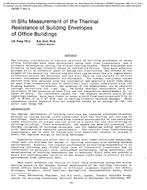Description
The thermal resistances of various sections of building envelopes in seven office buildings have been determined using heat flux transducers and a portable calorimeter during the winter heating season. These buildings are situated in various climatic zones of the United States. They have exterior masonry walls of different types of design and construction. The effects of the length of the measuring period and the time lag between the air temperature difference across the envelope and the heat flow on the results of in situ thermal resistance measurements are discussed. The thermal resistance values derived from data obtained with the calorimeter are generally lower than those by heat flux transducers due to additional heat losses associated with the framing members. In general, the accuracy of the measurement can be improved through correction for time lag. Reliable thermal resistance data are obtainable if the duration of heat flow and air temperature measurements is at least 24 hours. The resistance values for the masonry exterior walls of the buildings tested have been found to range widely from approximately 9 to 32 ft2· h·°F/Btu (2 to 6 m2·K/W) due to varying climatic building designs. These resistance values departed from the predicted values by an average of 14%, the worst case being 45%.
Citation: Symposium, ASHRAE Transactions, 1985, vol. 91, pt. 1B, Chicago
Product Details
- Published:
- 1985
- Number of Pages:
- 11
- File Size:
- 1 file , 1.4 MB
- Product Code(s):
- D-CH-85-11-3




